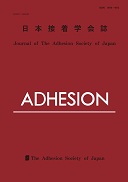All issues

Volume 48, Issue 6
Displaying 1-4 of 4 articles from this issue
- |<
- <
- 1
- >
- >|
Review
-
Hisashi MIYAFUJI2012 Volume 48 Issue 6 Pages 211-215
Published: June 01, 2012
Released on J-STAGE: August 31, 2016
JOURNAL FREE ACCESSDownload PDF (1796K)
Original Paper
-
Keisu HARA, Koichi OTSUKA, Makoto IMANAKA, Yoshihiro SAWADA2012 Volume 48 Issue 6 Pages 204-210
Published: June 01, 2012
Released on J-STAGE: June 30, 2014
JOURNAL FREE ACCESSEffect of colloidal silica addition in a chromate coating film on interfacial physical adhesive force between the coating film and a paint layer was studied. The physical adhesive force resulting from the chromate film on a steel sheet and the paint layer coated steel sphere was evaluated by an interfacial pull-off test. The interfacial force was measured by deflection of an aluminum cantilever beam which was bonded the painted steel sphere. Two kind of steel sheets modified with chromic acid which contained colloidal silica or no silica were prepared. Physical adhesive force was higher with colloidal silica containing chromate treated steel sheet than with no colloidal silica treated steel sheet. The effect of colloidal silica on the physical adhesive force shows the same tendency of adhesive strength evaluated as the peeling probability with the cross-cut method and the critical strain energy release rate at interfacial crack initiation using an end notched flexure specimen. These results are verified that the addition of colloidal silica in chromate film is effective to increase the physical adhesive force with paint layer, so the adhesive strength become stronger.View full abstractDownload PDF (2481K)
Original Paper
-
Masaaki YAMADA, Hayato KATO, Kinji TAKI2012 Volume 48 Issue 6 Pages 193-203
Published: June 01, 2012
Released on J-STAGE: June 30, 2014
JOURNAL FREE ACCESSWood species containing large amounts of oily components are difficult to bond to each other using conventional adhesives. In this study, five kinds of polyvinyl alcohol (PVA) with different degrees of saponification were prepared and systematically blended to develop novel adhesives that can bond such wood species. The phase structures of the polymers and their blends were observed using a scanning electron microscope (SEM), and dynamic mechanical properties were measured. The structures and properties of these materials were examined, and the following conclusions were drawn. The moisture absorptivity of the PVA polymers and their blends increased as the degree of saponification increased. When 4,4'-diphenylmethane diisocyanate (pMDI) was added to the polymer systems, most of the PVA samples showed very low moisture absorptivity. When the degree of saponification was nearly constant, the moisture absorptivity of the blended sample was lower than that of theun-blended PVA samples. When perfectly saponified PVA was blended with PVA of a low degree of saponification, the so-called "sea-island" structure was observed using SEM. In these blended systems, components with higher fractions tended to form the "sea" phase, and those with lower fractions formed the "island" phase. Tg of both N77 and N99 was found in the mechanical properties of blended PVA, which is confirming the fact that the blended PVA has a phase separated structure. And as the fraction of N99 increased, crystallinity of the material became higher. And almost the same tendency was observed in the systems where pMDI was added. Blended samples containing large amounts of PVA with a low degree of saponification showed high storage modulus (E') values in the rubbery plateau region, which is above the glass transition temperature, indicating high crosslinking density.View full abstractDownload PDF (4088K)
Original Paper
-
Yoko FURUTA, Masaaki YAMADA, Kinji TAKI, Takafumi KAWAMOTO, Shin-ichi ...2012 Volume 48 Issue 6 Pages 187-192
Published: June 01, 2012
Released on J-STAGE: June 30, 2014
JOURNAL FREE ACCESSIn this study VOC emission from two same wood-based materials glued with Epoxy adhesives (EP) contained a slight amount of toluene, xylene, ethylbenzene and styrene was measured by using a small chamber method according to JIS A 1901. Even more, VOC emission until 1day during setup specimen in the chamber as "the early VOC emission" was measured also, although this method didn't establish JIS A 1901. The result shows that the early VOC emission was a lot. Especially, the maximum time of emission curves was late in proportion with density of fiberboard. On the other hand, VOC emission behavior for PW and LVL was different from that of fiberboard (MDF etc.) , they have been diffused persistent a slight amount of VOC during long term. The reason was depended on the adhesive layer of PW and peeling veneer as wood element.View full abstractDownload PDF (2161K)
- |<
- <
- 1
- >
- >|